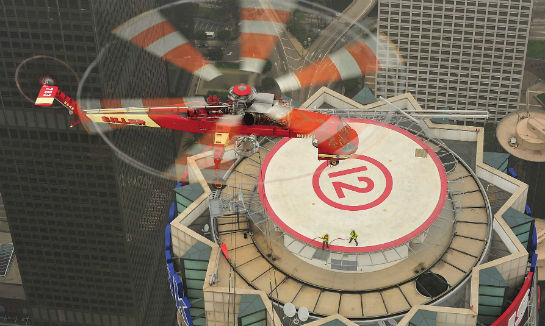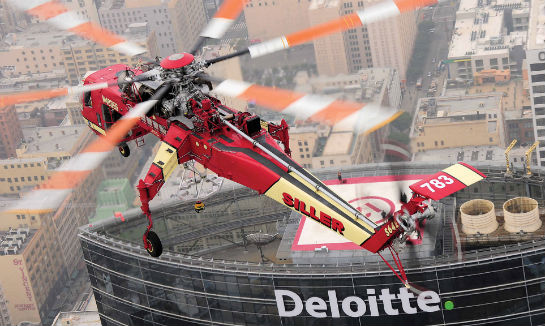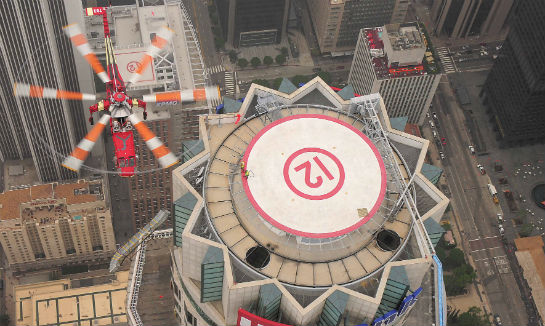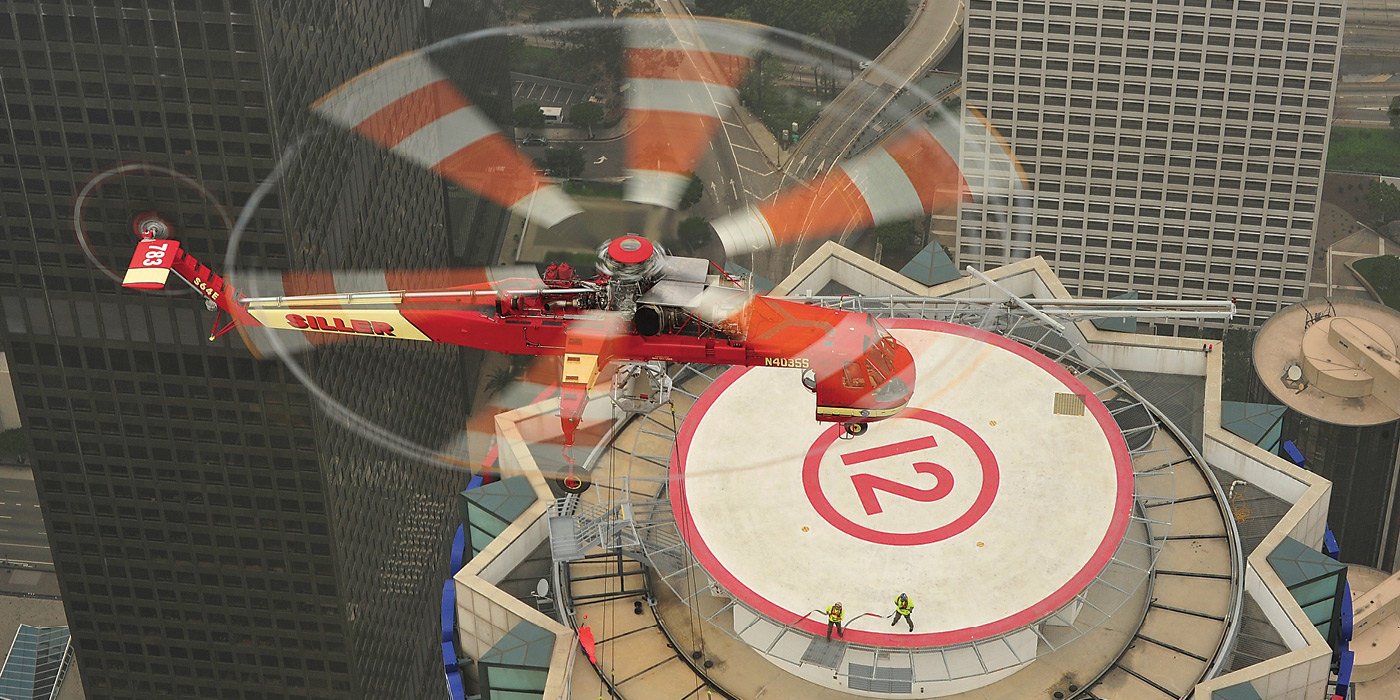
At 8:30 a.m. on March 19, 2016, after more than a year of detailed planning, a Sikorsky S-64E Skycrane belonging to Siller Helicopters of Yuba City, California, placed a delicate 45-foot-long, 15,000-pound (6,800-kilogram) glass plated “Skyslide” on a ledge of the tallest building in Los Angeles — the U.S. Bank Tower. The Skyslide will be the jewel in the crown of the tower’s OUE Skyspace observation deck when it opens in June, allowing thrill-seeking visitors the opportunity to slide between the building’s 70th and 69th floors, with nothing more than 1 ¼ inches of clear glass separating them from downtown Los Angeles 1,000 feet below.
The process of connecting the Skyslide to the Skyspace was, understandably, far from straightforward.
“The actual job was done in 30 minutes, but took close to 14 months to plan everything in detail,” Siller chief pilot Roger Douglass, pilot-in-command for the lift, told Vertical. During that time, numerous iterations of the lift plan and procedures were considered, analyzed, discussed and tested with simulated loads.
The first of these, in June 2015, saw the S-64E lift a wooden mock-up of the slide at Hemet-Ryan Airport in Riverside County, California. This test helped determine the aerodynamic tendencies of the aircraft’s rotor wash on the slide.
In January 2016, a second test lift was conducted at Siller’s Yuba City hangar, using a section of steel simulating the glass tube in dimensions and weight. The crew marked an outline on the ground in the same dimensions as the rooftop ledge in which the load was to be set (simulating the limited area for movement). This also allowed the ground crews to practice with the long tag ropes that would be used in the final lift, and become familiar with the noise and rotor wash of the helicopter.

The night before the lift, the Skycrane was positioned at Dodger Stadium, about five miles from the U.S. Bank Tower, to minimize the potential for weather or air traffic control delays during the transit to the job site. The stadium also served as a refueling and staging location if the need were to arise during the lift.
Early the next morning, the streets and sidewalks surrounding the U.S. Bank Tower were closed, as per the Federal Aviation Administration-approved Congested Area Plan.
Up above, Siller crews with radios were positioned strategic locations around the building, including on the ledge where the Skyslide was to be placed and on the rooftop helipad. There was also a crew on the street by the lift site. The radio contact enabled the flight crew to confirm the loads were hooked or unhooked properly, and having support crew call out the distance in feet, either vertically or horizontally, helped the flight crew gauge the aircraft’s position.
The day of the lift
Once the Skycrane launched from Dodger Stadium, it flew to pick up the Skyslide from a truck trailer on a street below the U.S. Bank Tower. The Skyslide — consisting of a steel frame with thick glass paneling — had been estimated to weight 12,000 lb. (5,444 kg) ahead of the lift, but ended up weighing nearly 15,000 lb.

Before the flight, the three-man flight crew (consisting of pilot-in-command Douglass, co-pilot Bill Neckels, and rear facing precision pilot Fran Tebbe) planned the fuel required to complete the lift, while not carrying too much in reserve so as to maximize performance. However, the crew also allowed for the load being heavier than quoted, which is not uncommon with such a complex operation. So, despite the load being 2,600 lb. (1,179 kg) more than expected, it was still well within the Skycrane’s 20,000-lb. (9,072 kg) maximum lift capacity.
The aircraft hovered for a few minutes while the load was attached to the winch system below its transmission. The Skycrane utilized its unique anti-rotation system structure to prevent its rotor wash spinning the external load — a critical requirement in this operation.
“There were confined area concerns where we were lifting the slide off a truck on the street,” said Douglass. “Once we started lifting the load, we needed to maneuver between buildings on our way up. When we got to the 69th story we then had to maneuver the slide onto the confined ledge where it would be placed.”
Douglass explained that during normal aft seat operations, the right seat pilot flies the load to a point where the aft seat pilot can take over the controls and place the load. However, this lift involved winching the load down to its resting place because of the distance from the helipad to the ledge, which required approximately 120 feet of total length. “This is challenging for the aft seat pilot, because the aft seat station only has 10 percent control authority,” said Douglass.
Neckels, a qualified long line pilot, was in the left seat to aid in setting the load should the extra length become an issue for aft seat pilot Tebbe with his limited control authority. “As it was, the load was flown from the right seat to the top of the building,” said Douglass. “Once we reached the top of the building and we turned right, to position the set site in view of the aft seat pilot, the left seat pilot took control as the right seat pilot began to lose reference to the building.”

Because of limited space on the 20-foot by 50-foot ledge, 125-foot-long tag ropes were used to help Tebbe as he eventually winched out 50 foot of cable (in addition to 75 foot of fixed anti-rotation rigging) to gain clearance from the rooftop above the 72nd floor.
“One of the concerns that we had was that the anti-rotation device would not be effective in preventing the load from trying to spin once the winching phase of the operation began,” Douglass said. “Long tag lines were used through anchors on the ledge to minimize any rotation — [and] this worked very well.
The 1 ¼-inch synthetic long lines were made by Lift-It Manufacturing, and were rated at 21,285 lb. (9,655 kg). “Each end of the line is spliced and fitted with a custom made thimble and master link to make the connection to the Skycrane and load,” said Lift-It’s Mike Gelskey, Jr. “The long line was then load tested to 42,570 vertical lbs. [19,309 kg] allowing for rope splicing to be ‘set’ and the structural integrity quantified.”
The crews working below the Skycrane guided the slide into place on the 69th floor, assisted by Siller project manager Marc Boyle.
After the load was set by Tebbe, the Neckels flew the empty rigging back to the street where it was released. The aircraft then recovered back to Dodger Stadium to pack up and return to its base, while the slide was later raised into its final position and permanently attached to the building by Siller’s customer, Steel City Glass.
“The pick itself was relatively routine — the challenges were getting the city permitting to work in a heavily congested area and doing it safely,” said Douglass. “Cockpit communication and procedures were well rehearsed and discussed repeatedly and there were several iterations before we arrived at the final plan.”
With the job complete, Siller showed its high level of expertise in heavy helicopter lift and precision placement. With 15,000 lb. of expensive glass under the Skycrane in a confined environment, Siller pulled off the impressive feat with style.






